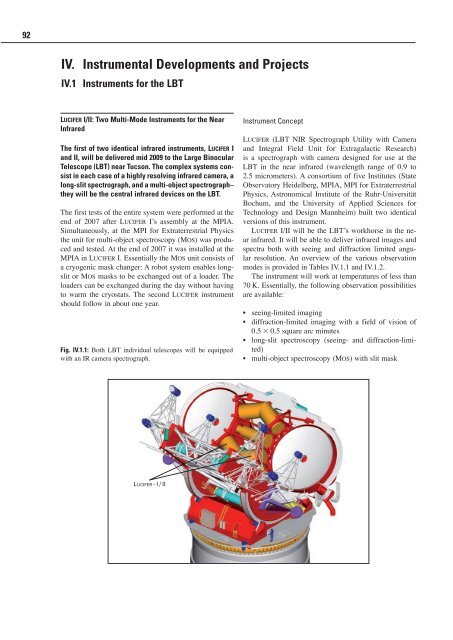Max Planck Institute for Astronomy - Annual Report 2007
Max Planck Institute for Astronomy - Annual Report 2007
Max Planck Institute for Astronomy - Annual Report 2007
Create successful ePaper yourself
Turn your PDF publications into a flip-book with our unique Google optimized e-Paper software.
92<br />
IV. Instrumental Developments and Projects<br />
IV.1 Instruments <strong>for</strong> the LBT<br />
Lucifer i/ii: Two Multi-Mode Instruments <strong>for</strong> the Near<br />
Infrared<br />
The first of two identical infrared instruments, Lucifer I<br />
and II, will be delivered mid 2009 to the Large Binocular<br />
Telescope (LBT) near Tucson. The complex systems consist<br />
in each case of a highly resolving infrared camera, a<br />
long-slit spectrograph, and a multi-object spectrograph–<br />
they will be the central infrared devices on the LBT.<br />
The first tests of the entire system were per<strong>for</strong>med at the<br />
end of <strong>2007</strong> after Lucifer I’s assembly at the MPIA.<br />
Simultaneously, at the MPI <strong>for</strong> Extraterrestrial Physics<br />
the unit <strong>for</strong> multi-object spectroscopy (Mos) was produced<br />
and tested. At the end of <strong>2007</strong> it was installed at the<br />
MPIA in Lucifer I. Essentially the Mos unit consists of<br />
a cryogenic mask changer: A robot system enables longslit<br />
or Mos masks to be exchanged out of a loader. The<br />
loaders can be exchanged during the day without having<br />
to warm the cryostats. The second Lucifer instrument<br />
should follow in about one year.<br />
Fig. IV.1.1: Both LBT individual telescopes will be equipped<br />
with an IR camera spectrograph.<br />
LUCIFER - I / II<br />
Instrument Concept<br />
Lucifer (LBT NIR Spectrograph Utility with Camera<br />
and Integral Field Unit <strong>for</strong> Extragalactic Research)<br />
is a spectrograph with camera designed <strong>for</strong> use at the<br />
LBT in the near infrared (wavelength range of 0.9 to<br />
2.5 micrometers). A consortium of five <strong>Institute</strong>s (State<br />
Observatory Heidelberg, MPIA, MPI <strong>for</strong> Extraterrestrial<br />
Physics, Astronomical <strong>Institute</strong> of the Ruhr-Universität<br />
Bochum, and the University of Applied Sciences <strong>for</strong><br />
Technology and Design Mannheim) built two identical<br />
versions of this instrument.<br />
Lucifer I/II will be the LBT’s workhorse in the near<br />
infrared. It will be able to deliver infrared images and<br />
spectra both with seeing and diffraction limited angular<br />
resolution. An overview of the various observation<br />
modes is provided in Tables IV.1.1 and IV.1.2.<br />
The instrument will work at temperatures of less than<br />
70 K. Essentially, the following observation possibilities<br />
are available:<br />
• seeing-limited imaging<br />
• diffraction-limited imaging with a field of vision of<br />
0.5 0.5 square arc minutes<br />
• long-slit spectroscopy (seeing- and diffraction-limited)<br />
• multi-object spectroscopy (Mos) with slit mask

















